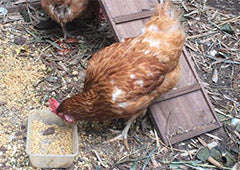The chicory plant has had a relative boom over the past ten years or so, however, in truth this particular herb has been on the market for well over 5000 years. More recently gourmets have been cutting their coffee with chicory to create a smoother, more mellow taste, however there are so many other ways one can take advantage of this incredibly healthy herb, like in salads or as a beautifully sautéed side dish. Chicory is a enormously beneficial plant that is not only good for you and your family, but your chickens and other pets as well. But, before start to fill your basket at the local farmer’s market or plant your chicory crop in your backyard, here are some essential questions about this time old herb that you may want to hear answered.
What is chicory?
As mentioned previously- chicory is a herb that has been used for both cooking and medicinal purposes over thousands of years. Originally native to Europe, North Africa and tropical Asia, chicory was brought to Australia in the 19th century due to its potential for great growth. In cooking, chicory is often used like spinach, cabbage or lettuce in French cuisine, as well as being an addition in some gourmet coffee blends or sometimes just sautéed and served on its own.
What are the different types of chicory and endives?
There is some confusion about the difference between chicory and endive. Endive and chicory are come from the same genus, however endives were grown in a more artificial way, the produce varieties like the Belgian endive, which are not exposed to sunlight and can grow all year long. Nevertheless, the term "endives" has become attached to some varieties of chicory (or endive?) that can be grown naturally in anyone's backyard. At the end of the day, whether you're talking endive or chicory, we are going to focus on the varieties that you can eat. So here is a look at some of the types or "chicory" or "endives" that will go great on your dinner plate.
Belgian endive (also known as Witloof chicory): this pale or chicory or endive resembles a more oblong cabbage, with a tightly packed head. It is so pale due to the fact it is grown in artificial green house conditions to prevent chlorophyll from colouring the leaves and changing the taste. This variety is commonly chopped and stirred into salad or used as a healthy substitute for chips and dip.
Red Belgian endive (also knowns as Witloof chicory): very similar the Belgian endive. This variety of chicory has a reddish tinge around the edge of its leaves. Be warned that this vairety does not keep its vibrant colour once cooked, instead developing a bluish tone. Though it is possible to cook this variety, it is better to serve chilled in salads or as a base for canapés.
Curly endive (also known as frisee): this variety of chicory looks very different from Belgin endives however it is still very much a part of the family. It has much looser, freer and curlier leaves, like lettuce, which go well in salads, but can also be sautéed and served with a healthy drizzle of balsamic vinegar.
Escarole: is a type of chicory slightly similar to curly endive, however the leaves are more compact, somewhat like iceberg lettuce. This particular variety is definitely on the green, crunchy and bitter side, so if you like your salad with a lot of flavour, be sure to add some to the mix.
How is chicory good for my health?
There are countless health benefits of eating chicory. From promoting healthy digestion to helping prevent heartburn, chicory could be a beneficial addition to almost anyone’s diet. It may also help reduce arthritis pain, assists with liver and gallbladder function, as well as boosting the immune system and reducing the risk of heart disease. Chicory is able to do all these amazing things for your health due to its dense and complex combination of mineral and vitamins that are housed inside its ludicrously healthy green leaves.
What types of vitamins and minerals can be found in chicory?
Chicory is rich in a number of vitamins and minerals that will surely have you ready to fight off the flu all year round. It contains a dense mix of vitamins A, B6, C, E and K, all of which help to fortify your immune system. Additionally, chicory is jam-packed with essential minerals, such as zinc, magnesium, manganese, calcium, iron, folic acid and potassium. So, if you can feel a sniffle coming on, make sure you put some chicory onto your plate.
What parts of the chicory plant do I eat?
It is recommended that you eat the green leaves from the chicory plant, in the same way you'd eat cabbage or leafy lettuce. Though some people do eat it raw, it is probably best to cook, boil or sauté the leaves to help reduce the bitter flavour. Some varieties of chicory plants grow beautiful azure-blue flowers, which are really quite pretty, but are not recommended for human consumption.
How can I cook chicory?
There are of course a number of different ways to prepare chicory, however like cauliflower, chicory is especially delicious when sautéed - perhaps use a variety like curly or Belgian endive. Here is an easy guide to sautéing chicory at home.
-
Wash chicory in the sink to remove any dirt or bacteria.
-
Cook approximately 1.5 KG of chicory in a large pot of boiling salted water (3 tablespoons of salt to about 6 litres of water) for around 5 minutes.
-
Drain the chicory well and store in a sealable bag in the fridge. Leave to cool overnight.
-
Heat ¼ cup of extra virgin olive oil in a large pan until it simmers.
-
Cook on a medium heat four large pieces of thinly sliced garlic in the pan, alongside ½ tsp of red pepper flakes until golden brown. This should only take a minute or so.
-
Add the chicory to the pan, stirring occasionally.
-
Increase the temperature to a medium-high heat and continue to cook until most of the liquid has evaporated. This should take approximately 3-5 minutes.
-
Stir ½ teaspoon of salt through before serving.
Other ways people enjoy eating chicory is serving raw in a salad, alongside other flavoursome greens and vegetables or pairing the bitter raw leaves with rich and lively foods like nuts, cheese and fruits.
Can I feed chicory to my chickens?
Feeding chicory to your flocks is one of the best things you can do for them! Chicory is a great balance of crude protein, energy and minerals, which is the perfect addition to a laying hen’s diet. Protein is one of the key components to generating a healthy egg, so if your chickens are having trouble laying, maybe you could consider giving them a few extra leaves of chicory along with their feed.
How can I grow my own chicory?
Chicory is a relatively easy plant to grow in the Australian climate. It grows actively from early spring to late autumn and can be planted nearly all year round, so long as the soil does not dip below 9 degrees Celsius. It is also a sturdy plant that is resistant to many diseases, as well as having a strong insect tolerance, which makes it almost ideal for the Australian environment. Here are some other fast facts that should help you create your own chicory crop…
-
Chicory prefers deep, fertile, well-drained soil, with a PH of approximately 4.3. So unlike a lot of other plants it can thrive in reasonably acidic conditions.
-
Seeds are small and delicate so it’s best to sow them only 10 mm into the soil.
-
When fertilizing, boost the soil with extra nitrogen, which can be found in chicken manure, so be sure to fill your compost up with plenty of your flock’s droppings.
-
Make sure that all the weeds are eradicated around the chicory plant, as it is especially sensitive to such things.
-
If you live in a colder climate, be sure to prevent the seedlings from becoming frosted at any stage.
-
Make sure that your chicory plant gets plenty of moisture in the lead up to summer.
Be sure to consult your local gardening store expert if you have any more questions about growing chicory. Also, check out this great article here that will help you get your garden started if you are a relatively new green-thumb.
If you’re looking for something new to add to your diet, be sure to consider picking yourself up some chicory whenever you next see it at the markets. Chickens are one of the best ways to promote the growth of chicory and most other plants in your garden, especially if you have a chicken tractor like the Taj Mahal or the Cluck House, which will help nourish the soil in your backyard. Be sure to consider getting some chickens if you are contemplating creating your own garden paradise, as these cute little feathered creatures will be your garden's best friend.


















